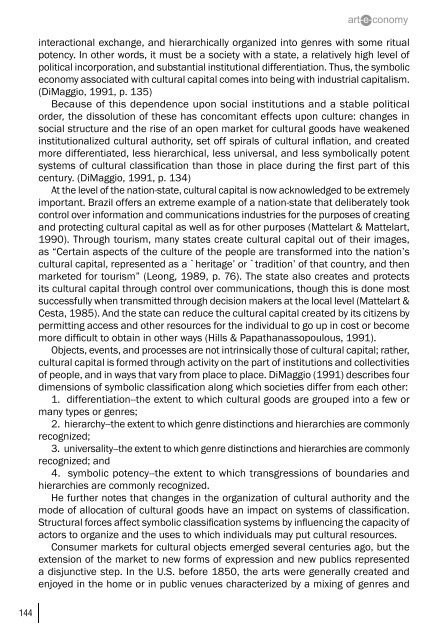art-e-conomy _ reader - marko stamenkovic
art-e-conomy _ reader - marko stamenkovic
art-e-conomy _ reader - marko stamenkovic
You also want an ePaper? Increase the reach of your titles
YUMPU automatically turns print PDFs into web optimized ePapers that Google loves.
144<br />
interactional exchange, and hierarchically organized into genres with some ritual<br />
potency. In other words, it must be a society with a state, a relatively high level of<br />
political incorporation, and substantial institutional differentiation. Thus, the symbolic<br />
e<strong>conomy</strong> associated with cultural capital comes into being with industrial capitalism.<br />
(DiMaggio, 1991, p. 135)<br />
Because of this dependence upon social institutions and a stable political<br />
order, the dissolution of these has concomitant effects upon culture: changes in<br />
social structure and the rise of an open market for cultural goods have weakened<br />
institutionalized cultural authority, set off spirals of cultural inflation, and created<br />
more differentiated, less hierarchical, less universal, and less symbolically potent<br />
systems of cultural classification than those in place during the first p<strong>art</strong> of this<br />
century. (DiMaggio, 1991, p. 134)<br />
At the level of the nation-state, cultural capital is now acknowledged to be extremely<br />
important. Brazil offers an extreme example of a nation-state that deliberately took<br />
control over information and communications industries for the purposes of creating<br />
and protecting cultural capital as well as for other purposes (Mattel<strong>art</strong> & Mattel<strong>art</strong>,<br />
1990). Through tourism, many states create cultural capital out of their images,<br />
as “Certain aspects of the culture of the people are transformed into the nation’s<br />
cultural capital, represented as a `heritage’ or `tradition’ of that country, and then<br />
marketed for tourism” (Leong, 1989, p. 76). The state also creates and protects<br />
its cultural capital through control over communications, though this is done most<br />
successfully when transmitted through decision makers at the local level (Mattel<strong>art</strong> &<br />
Cesta, 1985). And the state can reduce the cultural capital created by its citizens by<br />
permitting access and other resources for the individual to go up in cost or become<br />
more difficult to obtain in other ways (Hills & Papathanassopoulous, 1991).<br />
Objects, events, and processes are not intrinsically those of cultural capital; rather,<br />
cultural capital is formed through activity on the p<strong>art</strong> of institutions and collectivities<br />
of people, and in ways that vary from place to place. DiMaggio (1991) describes four<br />
dimensions of symbolic classification along which societies differ from each other:<br />
1. differentiation--the extent to which cultural goods are grouped into a few or<br />
many types or genres;<br />
2. hierarchy--the extent to which genre distinctions and hierarchies are commonly<br />
recognized;<br />
3. universality--the extent to which genre distinctions and hierarchies are commonly<br />
recognized; and<br />
4. symbolic potency--the extent to which transgressions of boundaries and<br />
hierarchies are commonly recognized.<br />
He further notes that changes in the organization of cultural authority and the<br />
mode of allocation of cultural goods have an impact on systems of classification.<br />
Structural forces affect symbolic classification systems by influencing the capacity of<br />
actors to organize and the uses to which individuals may put cultural resources.<br />
Consumer markets for cultural objects emerged several centuries ago, but the<br />
extension of the market to new forms of expression and new publics represented<br />
a disjunctive step. In the U.S. before 1850, the <strong>art</strong>s were generally created and<br />
enjoyed in the home or in public venues characterized by a mixing of genres and


